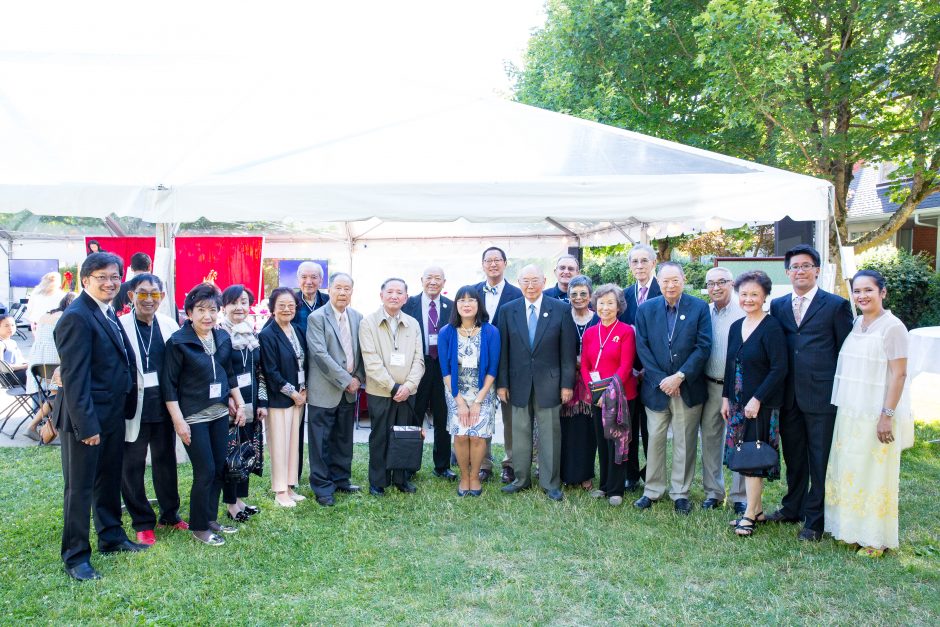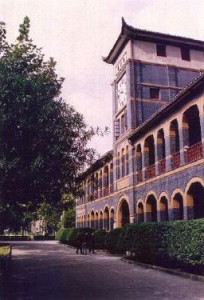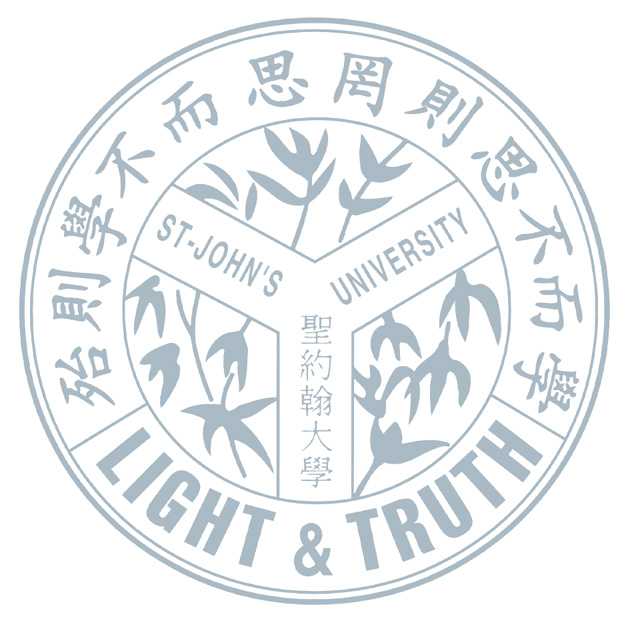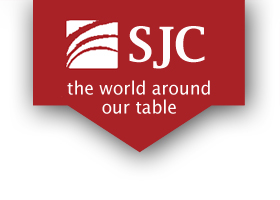
Principal Henry Yu, Associate Principal Chris Lee, President Santa J. Ono and UBC Ambassador Wendy Yip are pictured with many of our Johannean founders at the 20th anniversary of St. John’s College UBC in 2017.
St. John’s College, UBC was built in memory of the original St. John’s University, which was once one of China’s most prestigious and influential universities. Symbolically, the College is next to the Pacific Ocean facing Asia.
A Brief History of St. John’s College
by Yang Wu, Johannean, PhD Candidate – Modern Chinese History
St. John’s University (SJU) (1879-1952): The Inspiration Behind St. John’s College
St. John’s College is part of a proud heritage, which dates back to the famed St. John’s University in Shanghai, China. Founded by American Anglican missionaries in 1879, St. John’s University was one of the most prestigious post-secondary institutions in China during the first half of the 20th century. Often regarded as the Harvard or Yale of the country at the time, it was both a trail blazer in the development of higher learning in China and a facilitator of cultural exchange between China and the world. SJU introduced the American liberal arts model of education to the country and was the first in China to offer programs in psychology, journalism, business, and graduate degrees. The university was also the first post-secondary institution in China to include modern sports activities in its learning. It sent athletes to the first Asian Games and founded the earliest professional soccer and basketball teams in China. SJU also encouraged student self-management and started China’s first student associations and publications.
Curriculum at the university was based on a Christian core, but also promoted, in the liberal arts tradition, a free spirit of learning in which students selected most of their courses out of interest and were encouraged to study a broad range of subjects. The university used English as its pedagogical language, which enhanced the ability of students to communicate with the wider world. The university was also registered as a university in the US rather than China, making its degrees recognized by academic institutions abroad and encouraging overseas study among its graduates. It, however, also taught respect for China’s Confucian heritage and placed learning it on equal terms with Christianity and other knowledge. SJU excelled in this progressive outlook until political circumstances in China forced the closing of the institution in 1952.
St. John’s College (SJC): A Gift from Johanneans (1997 – )
SJU graduates, calling themselves Johanneans, have tried to keep alive the traditions of their alma mater following its closure by forming an alumni network with chapters around the w orld. They also funded the establishment of academic institutions that would bear the name of St. John’s and embody the cross-cultural learning and academic excellence of the original university. St. John’s College is one of three establishments around the world formed through their efforts. Created through the cooperation between global Johanneans and the University of British Columbia, St. John’s College was founded in 1997.
orld. They also funded the establishment of academic institutions that would bear the name of St. John’s and embody the cross-cultural learning and academic excellence of the original university. St. John’s College is one of three establishments around the world formed through their efforts. Created through the cooperation between global Johanneans and the University of British Columbia, St. John’s College was founded in 1997.
Unlike its predecessor, SJC is not a religiously affiliated teaching facility. It, however, carries on the liberal arts tradition and cultural exchange of St. John’s University by serving as a forum for communication and bond building between people of different cultural and academic backgrounds. The College provides residence to graduate students, junior faculty, visiting scholars and postdoctoral fellows at UBC and hosts a variety of academic events on campus. Its goal through this is to bring together learned minds that span the different academic and national divides and to enrich and broaden their understanding through participation in College activities and living with those different from themselves. St. John’s, through this process, hopes to produce a new generation of Johanneans who would bring achievement and service to their home communities and work towards the larger cause of global cooperation.
聖約翰學院簡史
聖約翰大學(1879年至1952年):聖約翰學院背景的啟示
聖約翰學院是一個值得驕傲的文化遺產,其歷史可以追溯到著名的上海聖約翰大學。該大學於1879年由美國聖公會傳教士創立,在二十世紀的前半葉成為中國最負盛名的高等教育學府之一,往往被視為當時中國的哈佛或耶魯,它是一個中國高等教育發展的開拓者,也是中國與世界文化交流的促進者。聖約翰大學引進了美國的自由文化教育模式,最早向中國提供了心理學、新聞學和商貿學教育,以及研究生學位,它也是第一個中國高校把現代體育教育納入學習活動。它向第一屆亞運會選送了運動員,並在中國成立最早的專業足球和籃球隊。聖約翰大學還鼓勵學生自我管理,並開創了中國的第一個學生組織和出版物。
聖約翰大學的基礎課程是以基督教為核心,但它的自由文化教育傳統同時也促進了自由探討的學術精神,讓學生們根據興趣選擇他們的大多課程,鼓勵他們選修廣泛的學科。大學使用英語作為教學語言,提高學生於世界上的溝通能力。它被註冊為一所美國大學,而不是中國的大學,使得它授予的學位被國外的大學公認,同時也鼓勵畢業生到海外留學。然而它也尊重中國的儒家傳統,並把學習基督教和學習其他知識放在同等高度。聖約翰大學在推動進步觀念方面成績卓著,直到中國的政治環境發生變化,於1952年被迫關閉。
聖約翰校友:聖約翰大學的遺產
作為一所以高標準錄取學生的大學,聖約翰為現代中國造就了一些最傑出的人物。這些人中有外交官顧維鈞,他曾代表中國出席1919年凡爾賽和平會議;榮毅仁,中國第一個推進經濟改革的億萬富翁;魯平,在1997年處理過香港移交中國,及製片人鄒文懐在二十世紀七十年代成功地把香港武俠電影打入國際舞台。聖約翰的教育把自由文化教育的創造力和基督教與儒家的自律、勤奮和為公共服務的精神相結合。遵循這條道路,聖約翰校友在整個二十世紀和二十一世紀為中國和全球的華人社會贏得榮譽,並在為建立中國,中國文化和更廣闊的世界關係上成為關鍵力量。
聖約翰學院:聖約翰校友的禮物(1997年– )
聖約翰校友曾試圖保持其傳統。母校關閉後,他們組成的校友會網絡遍布世界各地。他們還出資建立學術機構,傳承聖約翰的名字,體現原大學的跨文化學習和學術卓越的傳統。設在不列顛哥倫比亞大學 (University of British Columbia) 的聖約翰學院(St. John’s College) 是他們在世界各地建立的三個機構之一。通過全球的聖約翰校友和UBC的努力及合作,聖約翰學院成立於1997年。與它的前身不同,聖約翰學院不是一個附屬於宗教的教學機構。然而它繼承了聖約翰大學的自由文化教育和跨文化交流的傳統,成為一個不同文化和學術背景的人的溝通和建立聯繫之論壇。聖約翰學院為UBC的研究生,新任教授,訪問學者和博士後研究員提供住所,並在校園內舉辦各種學術活動。它的目標是通過努力來集中涵蓋各類學術,各個國度的智囊,通過參與學院的活動,與和自己不同的人生活在一起,來豐富和拓寬自己對事物的理解。聖約翰學院希望通過這些方法,培養出新一代的聖約翰校友,把他們的成就和服務帶回家園,並為實現全球合作的更大事業訴諸努力。
Author: Yang Wu, SJC Resident
 The Light & Truth crest of St. John’s University (founded in Shanghai, China in 1879 and in operation until 1952) lives on at St. John’s College, UBC as does the spirit of “Light and Truth”. In 1988, Johanneans (alumni of St. John’s University) met at the first world reunion and committed to perpetuate the spirit of St. John’s, which subsequently led to the establishment of St. John’s College in 1997. “Light and Truth” underscores the values of honesty, generosity, justice and integrity in serving society. The Chinese motto is taken from Confucius: “Learning without thinking is labour lost, thinking without learning is perilous.” Both expressions are included in the emblem.
The Light & Truth crest of St. John’s University (founded in Shanghai, China in 1879 and in operation until 1952) lives on at St. John’s College, UBC as does the spirit of “Light and Truth”. In 1988, Johanneans (alumni of St. John’s University) met at the first world reunion and committed to perpetuate the spirit of St. John’s, which subsequently led to the establishment of St. John’s College in 1997. “Light and Truth” underscores the values of honesty, generosity, justice and integrity in serving society. The Chinese motto is taken from Confucius: “Learning without thinking is labour lost, thinking without learning is perilous.” Both expressions are included in the emblem.
